Long-Term Ground-Based Measurements of Aerosol Optical Depth over Kuwait City
Abstract
:1. Introduction
2. Materials and Methods
2.1. CIMEL Sun-Sky Radiometer
2.2. HYSPLIT Model and Cluster Analysis
2.3. MODIS AOD Dataset
2.4. ESA CCI Soil Moisture Dataset
3. Results & Discussion
3.1. AOD Levels and Seasonal Variation
3.2. Origin of Air masses Over Kuwait
4. Conclusions
- Mean daily AOD500 over Kuwait is 0.45 ± 0.29 and the corresponding value of Ångström coefficient (AE 44/870), is 0.61 ± 0.39. These values are indicative of the strong sources of particulate matter in the area, which contribute to the degradation of air quality at the regional scale.
- Recorded high AOD500 values (0.74–2.91), are due to regional sand and dust storm events, which are affecting Kuwait with a mean annual frequency of almost 20 days/year.
- The position of Kuwait in the Middle East defines the annual cycle of AOD500 and AE. The patterns observed in Kuwait exhibits a pronounced spring mode, with maximum values observed during May. High aerosol loads are affecting the state also during the summer months (0.50–0.55), while minimum values are observed during fall (0.33–0.47) and winter months (0.26–0.29).
- Ground-based retrieved AOD is compared against MODIS retrievals obtained over the area for the same time period. On an annual basis, MODIS found to have a mean overestimation of AOD up to 15%.
- The long-term analysis of AOD500 illustrated a negative trend percentage, of 3.3 ± 0.7% per year. The corresponding trend analysis of AE observations shows a positive change of 4.8 ± 0.1%.
- The aforementioned trends and annual cycles of AOD500 and AE, are strongly related to the soil moisture conditions over the desert area of Kuwait and land cover change and increased anthropogenic activity of the city during the last decade.
- The following general points are concluded from the trajectory cluster analysis: (i) The greatest contribution (almost 80%) to the annually averaged AOD, comes from regional and local dust sources (56% from Saudi Arabia and 21% from Iran-Iraq). (ii) Natural and anthropogenic particles are transported from the northeastern Mediterranean and African coast mixed with dust from local regions, accounting for 22% of the mean annual aerosol load.
Author Contributions
Funding
Conflicts of Interest
References
- IPCC Climate Change. The Physical Science Basis. In Contribution of Working Group I to the Fifth Assessment Report of the Intergovernmental Panel on Climate Change; Cambridge University Press: Cambridge, UK; New York, NY, USA, 2013; ISBN 978-1-107-66182-0. [Google Scholar]
- Tegen, I.; Lacis, A.A. Modeling of particle size distribution and its influence on the radiative properties of mineral dust aerosol. J. Geophys. Res. Atmos. 1996, 101, 19237–19244. [Google Scholar] [CrossRef] [Green Version]
- Berthier, S.; Chazette, P.; Couvert, P.; Pelon, J.; Dulac, F.; Thieuleux, F.; Moulin, C.; Pain, T. Desert dust aerosol columnar properties over ocean and continental Africa from Lidar in-Space Technology Experiment (LITE) and Meteosat synergy. J. Geophys. Res. 2006, 111. [Google Scholar] [CrossRef] [Green Version]
- Kazadzis, S.; Raptis, P.; Kouremeti, N.; Amiridis, V.; Arola, A.; Gerasopoulos, E.; Schuster, G.L. Aerosol absorption retrieval at ultraviolet wavelengths in a complex environment. Atmos. Meas. Tech. 2016, 9, 5997–6011. [Google Scholar] [CrossRef] [Green Version]
- Kosmopoulos, P.G.; Kazadzis, S.; Taylor, M.; Athanasopoulou, E.; Speyer, O.; Raptis, P.I.; Marinou, E.; Proestakis, E.; Solomos, S.; Gerasopoulos, E.; et al. Dust impact on surface solar irradiance assessed with model simulations, satellite observations and ground-based measurements. Atmos. Meas. Tech. 2017, 10, 2435–2453. [Google Scholar] [CrossRef] [Green Version]
- Pappalardo, G.; Amodeo, A.; Apituley, A.; Comeron, A.; Freudenthaler, V.; Linné, H.; Ansmann, A.; Bösenberg, J.; D’Amico, G.; Mattis, I.; et al. EARLINET: Towards an advanced sustainable European aerosol lidar network. Atmos. Meas. Tech. 2014, 7, 2389–2409. [Google Scholar] [CrossRef] [Green Version]
- Welton, E.J.; Campbell, J.R. Micropulse lidar signals: Uncertainty analysis. J. Atmos. Ocean. Technol. 2002, 19, 2089–2094. [Google Scholar] [CrossRef]
- Holben, B.N.; Eck, T.F.; Slutsker, I.; Tanre, D.; Buis, J.P.; Setzer, A.; Vermote, E.; Reagan, J.A.; Kaufman, Y.J.; Nakajima, T. AERONET—A federated instrument network and data archive for aerosol characterization. Remote Sens. Environ. 1998, 66, 1–16. [Google Scholar] [CrossRef]
- Sioris, C.E.; Abboud, I.; Fioletov, V.E.; McLinden, C.A. AEROCAN, the Canadian sub-network of AERONET: Aerosol monitoring and air quality applications. Atmos. Environ. 2017, 167, 444–457. [Google Scholar] [CrossRef]
- Takamura, T.; Nakajima, T. Overview of SKYNET and its Activities. Opt. Pura. Apl. 2004, 37, 3303–3308. [Google Scholar]
- Nakajima, T.; Yoon, S.-C.; Ramanathan, V.; Shi, G.-Y.; Takemura, T.; Higurashi, A.; Takamura, T.; Aoki, K.; Sohn, B.-J.; Kim, S.-W.; et al. Overview of the Atmospheric Brown Cloud East Asian Regional Experiment 2005 and a study of the aerosol direct radiative forcing in east Asia. J. Geophys. Res. Atmos. 2007, 112. [Google Scholar] [CrossRef] [Green Version]
- Nyeki, S.; Wehrli, C.; Gröbner, J.; Kouremeti, N.; Wacker, S.; Labuschagne, C.; Mbatha, N.; Brunke, E.-G. The GAW-PFR aerosol optical depth network: The 2008–2013 time series at Cape Point Station, South Africa: AOD (2008–2013) AT CAPE POINT, S. AFRICA. J. Geophys. Res. Atmos. 2015, 120, 5070–5084. [Google Scholar] [CrossRef]
- Amiridis, V.; Marinou, E.; Tsekeri, A.; Wandinger, U.; Schwarz, A.; Giannakaki, E.; Mamouri, R.; Kokkalis, P.; Binietoglou, I.; Solomos, S.; et al. LIVAS: A 3-D multi-wavelength aerosol/cloud database based on CALIPSO and EARLINET. Atmos. Chem. Phys. 2015, 15, 7127–7153. [Google Scholar] [CrossRef]
- Marinou, E.; Amiridis, V.; Binietoglou, I.; Tsikerdekis, A.; Solomos, S.; Proestakis, E.; Konsta, D.; Papagiannopoulos, N.; Tsekeri, A.; Vlastou, G.; et al. Three-dimensional evolution of Saharan dust transport towards Europe based on a 9-year EARLINET-optimized CALIPSO dataset. Atmos. Chem. Phys. 2017, 17, 5893–5919. [Google Scholar] [CrossRef] [Green Version]
- Proestakis, E.; Amiridis, V.; Marinou, E.; Georgoulias, A.K.; Solomos, S.; Kazadzis, S.; Chimot, J.; Che, H.; Alexandri, G.; Binietoglou, I.; et al. Nine-year spatial and temporal evolution of desert dust aerosols over South and East Asia as revealed by CALIOP. Atmos. Chem. Phys. 2018, 18, 1337–1362. [Google Scholar] [CrossRef] [Green Version]
- Papayannis, A.; Amiridis, V.; Mona, L.; Tsaknakis, G.; Balis, D.; Bösenberg, J.; Chaikovski, A.; De Tomasi, F.; Grigorov, I.; Mattis, I.; et al. Systematic lidar observations of Saharan dust over Europe in the frame of EARLINET (2000–2002). J. Geophys. Res. Atmos. 2008, 113, D10204. [Google Scholar] [CrossRef]
- Mona, L.; Pappalardo, G.; Amodeo, A.; D’Amico, G.; Madonna, F.; Boselli, A.; Giunta, A.; Russo, F.; Cuomo, V. One year of CNR-IMAA multi-wavelength Raman lidar measurements in coincidence with CALIPSO overpasses: Level 1 products comparison. Atmos. Chem. Phys. 2009, 9, 7213–7228. [Google Scholar] [CrossRef] [Green Version]
- Mamouri, R.E.; Amiridis, V.; Papayannis, A.; Giannakaki, E.; Tsaknakis, G.; Balis, D.S. Validation of CALIPSO space-borne-derived attenuated backscatter coefficient profiles using a ground-based lidar in Athens, Greece. Atmos. Meas. Tech. 2009, 2, 513–522. [Google Scholar] [CrossRef] [Green Version]
- Amiridis, V.; Wandinger, U.; Marinou, E.; Giannakaki, E.; Tsekeri, A.; Basart, S.; Kazadzis, S.; Gkikas, A.; Taylor, M.; Baldasano, J.; et al. Optimizing CALIPSO Saharan dust retrievals. Atmos. Chem. Phys. 2013, 13, 12089–12106. [Google Scholar] [CrossRef] [Green Version]
- Papagiannopoulos, N.; Mona, L.; Alados-Arboledas, L.; Amiridis, V.; Baars, H.; Binietoglou, I.; Bortoli, D.; D’Amico, G.; Giunta, A.; Guerrero-Rascado, J.L.; et al. CALIPSO climatological products: Evaluation and suggestions from EARLINET. Atmos. Chem. Phys. 2016, 16, 2341–2357. [Google Scholar] [CrossRef]
- Kim, S.-W.; Chazette, P.; Dulac, F.; Sanak, J.; Johnson, B.; Yoon, S.-C. Vertical structure of aerosols and water vapor over West Africa during the African monsoon dry season. Atmos. Chem. Phys. 2009, 9, 8017–8038. [Google Scholar] [CrossRef] [Green Version]
- Marticorena, B.; Chatenet, B.; Rajot, J.L.; Traoré, S.; Coulibaly, M.; Diallo, A.; Koné, I.; Maman, A.; NDiaye, T.; Zakou, A. Temporal variability of mineral dust concentrations over West Africa: Analyses of a pluriannual monitoring from the AMMA Sahelian Dust Transect. Atmos. Chem. Phys. 2010, 10, 8899–8915. [Google Scholar] [CrossRef]
- Ansmann, A.; Petzold, A.; Kandler, K.; Tegen, I.; Wendisch, M.; Müller, D.; Weinzierl, B.; Müller, T.; Heintzenberg, J. Saharan Mineral Dust Experiments SAMUM-1 and SAMUM-2: What have we learned? Tellus B 2011, 63, 403–429. [Google Scholar] [CrossRef] [Green Version]
- Veselovskii, I.; Goloub, P.; Podvin, T.; Bovchaliuk, V.; Derimian, Y.; Augustin, P.; Fourmentin, M.; Tanre, D.; Korenskiy, M.; Whiteman, D.N.; et al. Retrieval of optical and physical properties of African dust from multiwavelength Raman lidar measurements during the SHADOW campaign in Senegal. Atmos. Chem. Phys. 2016, 16, 7013–7028. [Google Scholar] [CrossRef] [Green Version]
- Tang, K.; Huang, Z.; Huang, J.; Maki, T.; Zhang, S.; Shimizu, A.; Ma, X.; Shi, J.; Bi, J.; Zhou, T.; et al. Characterization of atmospheric bioaerosols along the transport pathway of Asian dust during the Dust-Bioaerosol 2016 Campaign. Atmos. Chem. Phys. 2018, 18, 7131–7148. [Google Scholar] [CrossRef]
- Zhou, T.; Xie, H.; Bi, J.; Huang, Z.; Huang, J.; Shi, J.; Zhang, B.; Zhang, W. Lidar Measurements of Dust Aerosols during Three Field Campaigns in 2010, 2011 and 2012 over Northwestern China. Atmosphere 2018, 9, 173. [Google Scholar] [CrossRef]
- Mamouri, R.E.; Ansmann, A.; Nisantzi, A.; Kokkalis, P.; Schwarz, A.; Hadjimitsis, D. Low Arabian dust extinction-to-backscatter ratio: Arabian dust lidar ratio. Geophys. Res. Lett. 2013, 40, 4762–4766. [Google Scholar] [CrossRef]
- Nisantzi, A.; Mamouri, R.E.; Ansmann, A.; Schuster, G.L.; Hadjimitsis, D.G. Middle East versus Saharan dust extinction-to-backscatter ratios. Atmos. Chem. Phys. 2015, 15, 7071–7084. [Google Scholar] [CrossRef] [Green Version]
- Sabbah, I.; Al-Mudhaf, H.F.; Al-Kandari, A.; Al-Sharifi, F. Remote sensing of desert dust over Kuwait: Long-term variation. Atmos. Pollut. Res. 2012, 3, 95–104. [Google Scholar] [CrossRef]
- Al-Dousari, A.M.; Al-Awadhi, J.; Ahmed, M. Dust fallout characteristics within global dust storm major trajectories. Arab. J. Geosci. 2013, 6, 3877–3884. [Google Scholar] [CrossRef]
- Al Jassar, H.K.; Rao, K.S. Assessment of soil moisture through field measurements and AMSR-E remote sensing data analysis over Kuwait desert. Kuwait J. Sci. 2015, 42, 250–260. [Google Scholar]
- Sabbah, I.; Léon, J.-F.; Sorribas, M.; Guinot, B.; Córdoba-Jabonero, C.; de Souza, A.; Al Sharifi, F. Dust and dust storms over Kuwait: Ground-based and satellite observations. J. Atmos. Sol.-Terr. Phys. 2018, 179, 105–113. [Google Scholar] [CrossRef]
- Dubovik, O.; King, M.D. A flexible inversion algorithm for retrieval of aerosol optical properties from Sun and sky radiance measurements. J. Geophys. Res. Atmos. 2000, 105, 20673–20696. [Google Scholar] [CrossRef] [Green Version]
- Dubovik, O.; Sinyuk, A.; Lapyonok, T.; Holben, B.N.; Mishchenko, M.; Yang, P.; Eck, T.F.; Volten, H.; Muñoz, O.; Veihelmann, B.; et al. Application of spheroid models to account for aerosol particle nonsphericity in remote sensing of desert dust. J. Geophys. Res. Atmos. 2006, 111, D11208. [Google Scholar] [CrossRef]
- Giles, D.; Holben, B.N.; Smirnov, A.; Eck, T.F.; Slutsker, I.; Sorokin, M.; Schafer, J.; Sinyuk, A. Evaluation of AERONET AOD Measurements in the Version 3 Database. Lidar Data Its Use Model Verification Data Assim. 2016. Available online: https://aeronet.gsfc.nasa.gov/new_web/Documents/AERONET_V3_AOD.pdf (accessed on 15 October 2018).
- Fragkos, K.; Antonescu, B.; Ene, D.; Efstathiou, G.A.; Belegante, L. Assessment of the total precipitable water from a sun-photometer, microwave radiometer and radiosondes at a continental site in southeastern Europe. Atmos. Meas. Tech. Discuss. 2018, 1–30. [Google Scholar] [CrossRef]
- Stein, A.F.; Draxler, R.R.; Rolph, G.D.; Stunder, B.J.B.; Cohen, M.D.; Ngan, F. NOAA’s HYSPLIT Atmospheric Transport and Dispersion Modeling System. Bull. Am. Meteorol. Soc. 2015, 96, 2059–2077. [Google Scholar] [CrossRef]
- Ichoku, C. A spatio-temporal approach for global validation and analysis of MODIS aerosol products. Geophys. Res. Lett. 2002, 29. [Google Scholar] [CrossRef] [Green Version]
- Liu, Y.Y.; Dorigo, W.A.; Parinussa, R.M.; de Jeu, R.A.M.; Wagner, W.; McCabe, M.F.; Evans, J.P.; van Dijk, A.I.J.M. Trend-preserving blending of passive and active microwave soil moisture retrievals. Remote Sens. Environ. 2012, 123, 280–297. [Google Scholar] [CrossRef]
- Dorigo, W.; Wagner, W.; Albergel, C.; Albrecht, F.; Balsamo, G.; Brocca, L.; Chung, D.; Ertl, M.; Forkel, M.; Gruber, A.; et al. ESA CCI Soil Moisture for improved Earth system understanding: State-of-the art and future directions. Remote Sens. Environ. 2017, 203, 185–215. [Google Scholar] [CrossRef]
- Gruber, A.; Dorigo, W.A.; Crow, W.; Wagner, W. Triple Collocation-Based Merging of Satellite Soil Moisture Retrievals. IEEE Trans. Geosci. Remote Sens. 2017, 55, 6780–6792. [Google Scholar] [CrossRef]
- Saeed, T.M.; Al-Dashti, H.; Spyrou, C. Aerosol’s optical and physical characteristics and direct radiative forcing during a shamal dust storm, a case study. Atmos. Chem. Phys. 2014, 14, 3751–3769. [Google Scholar] [CrossRef]
- Solomos, S.; Ansmann, A.; Mamouri, R.-E.; Binietoglou, I.; Patlakas, P.; Marinou, E.; Amiridis, V. Remote sensing and modelling analysis of the extreme dust storm hitting the Middle East and eastern Mediterranean in September 2015. Atmos. Chem. Phys. 2017, 17, 4063–4079. [Google Scholar] [CrossRef]
- Al-Dousari, A.; Doronzo, D.; Ahmed, M. Types, Indications and Impact Evaluation of Sand and Dust Storms Trajectories in the Arabian Gulf. Sustainability 2017, 9, 1526. [Google Scholar] [CrossRef]
- Moosmüller, H.; Engelbrecht, J.P.; Skiba, M.; Frey, G.; Chakrabarty, R.K.; Arnott, W.P. Single scattering albedo of fine mineral dust aerosols controlled by iron concentration: MINERAL DUST SINGLE SCATTERING ALBEDO. J. Geophys. Res. Atmos. 2012, 117. [Google Scholar] [CrossRef]
- Eck, T.F.; Holben, B.N.; Reid, J.S.; Dubovik, O.; Smirnov, A.; O’Neill, N.T.; Slutsker, I.; Kinne, S. Wavelength dependence of the optical depth of biomass burning, urban and desert dust aerosols. J. Geophys. Res. Atmos. 1999, 104, 31333–31349. [Google Scholar] [CrossRef]
- Chomette, O.; Legrand, M. Determination of the wind speed threshold for the emission of desert dust using satellite remote sensing in the thermal infrared. J. Geophys. Res. Atmos. 1999, 104, 31207–31215. [Google Scholar] [CrossRef] [Green Version]
- Ishizuka, M. An observational study of soil moisture effects on wind erosion at a gobi site in the Taklimakan Desert. J. Geophys. Res. 2005, 110. [Google Scholar] [CrossRef] [Green Version]
- Cowie, S.M.; Knippertz, P.; Marsham, J.H. Are vegetation-related roughness changes the cause of the recent decrease in dust emission from the Sahel? Geophys. Res. Lett. 2013, 40, 1868–1872. [Google Scholar] [CrossRef] [PubMed] [Green Version]
- Kim, H.; Choi, M. Impact of soil moisture on dust outbreaks in East Asia: Using satellite and assimilation data. Geophys. Res. Lett. 2015, 42, 2789–2796. [Google Scholar] [CrossRef] [Green Version]
- Klingmüller, K.; Pozzer, A.; Metzger, S.; Stenchikov, G.L.; Lelieveld, J. Aerosol optical depth trend over the Middle East. Atmos. Chem. Phys. 2016, 16, 5063–5073. [Google Scholar] [CrossRef]
- Ju, J.; Slingo, J. The Asian summer monsoon and ENSO. Q. J. R. Meteorol. Soc. 1995, 121, 1133–1168. [Google Scholar] [CrossRef]
- Gerasopoulos, E.; Amiridis, V.; Kazadzis, S.; Kokkalis, P.; Eleftheratos, K.; Andreae, M.O.; Andreae, T.W.; El-Askary, H.; Zerefos, C.S. Three-year ground based measurements of aerosol optical depth over the Eastern Mediterranean: The urban environment of Athens. Atmos. Chem. Phys. 2011, 11, 2145–2159. [Google Scholar] [CrossRef]
- Boselli, A.; Caggiano, R.; Cornacchia, C.; Madonna, F.; Mona, L.; Macchiato, M.; Pappalardo, G.; Trippetta, S. Multi year sun-photometer measurements for aerosol characterization in a Central Mediterranean site. Atmos. Res. 2012, 104–105, 98–110. [Google Scholar] [CrossRef]
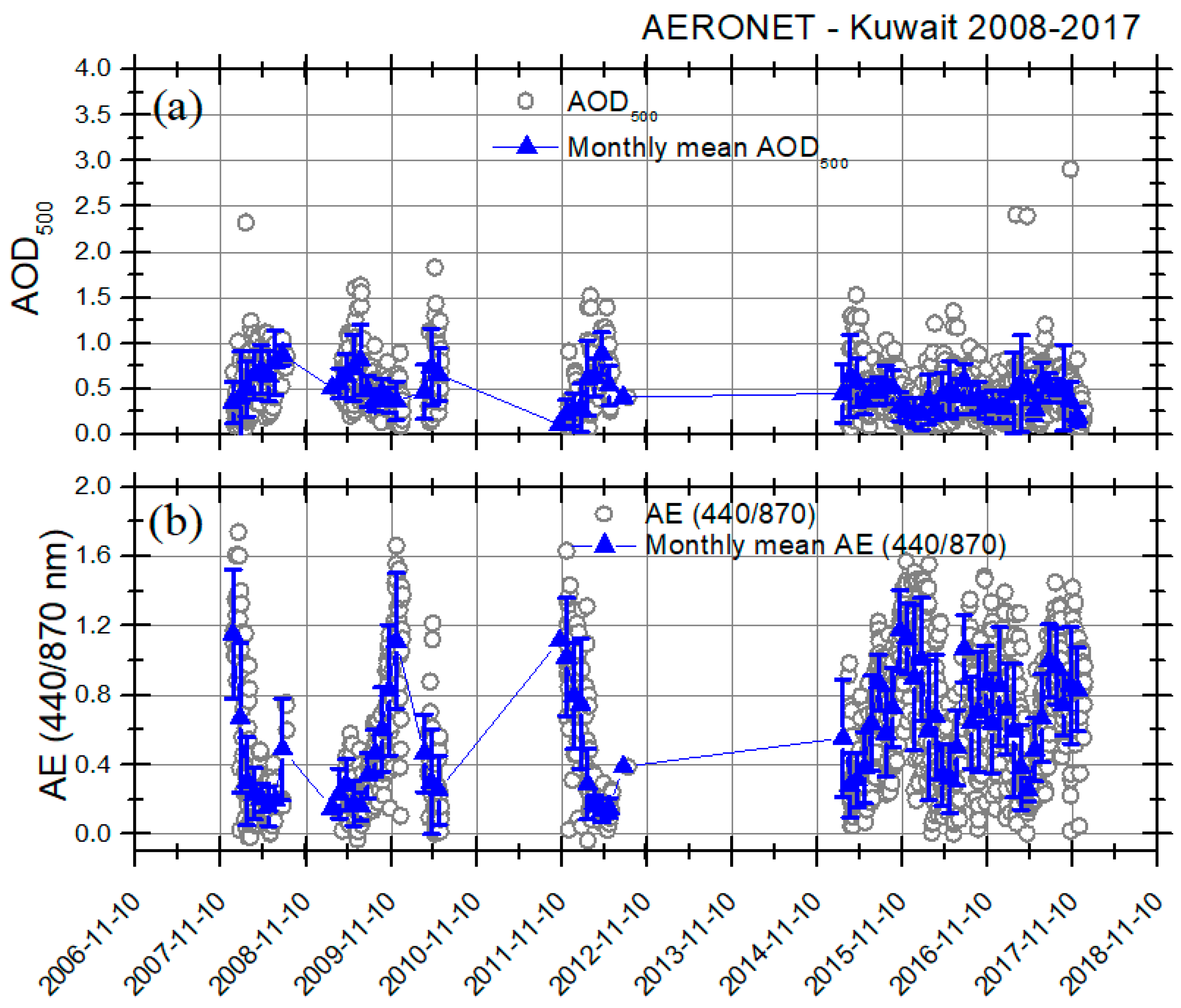

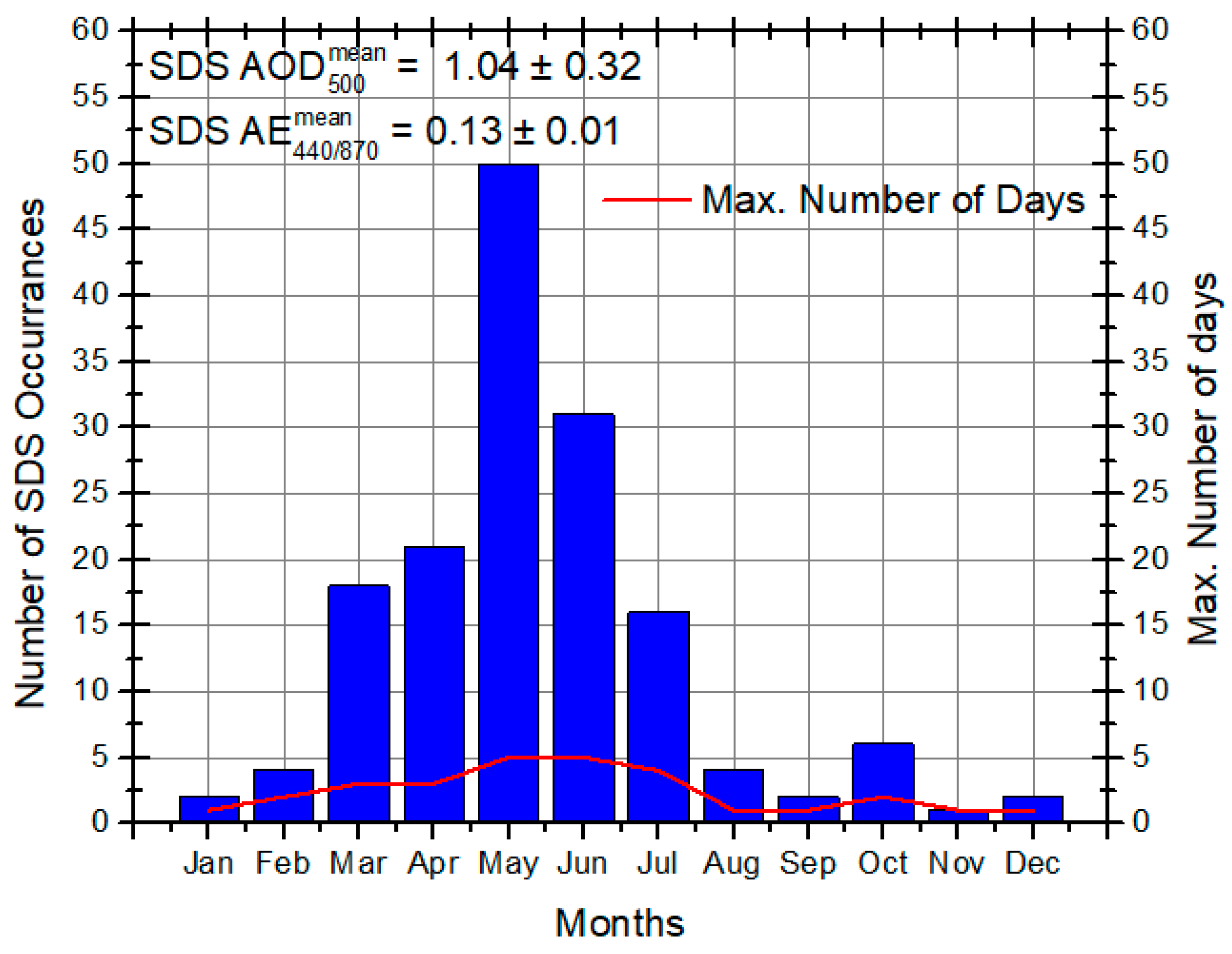


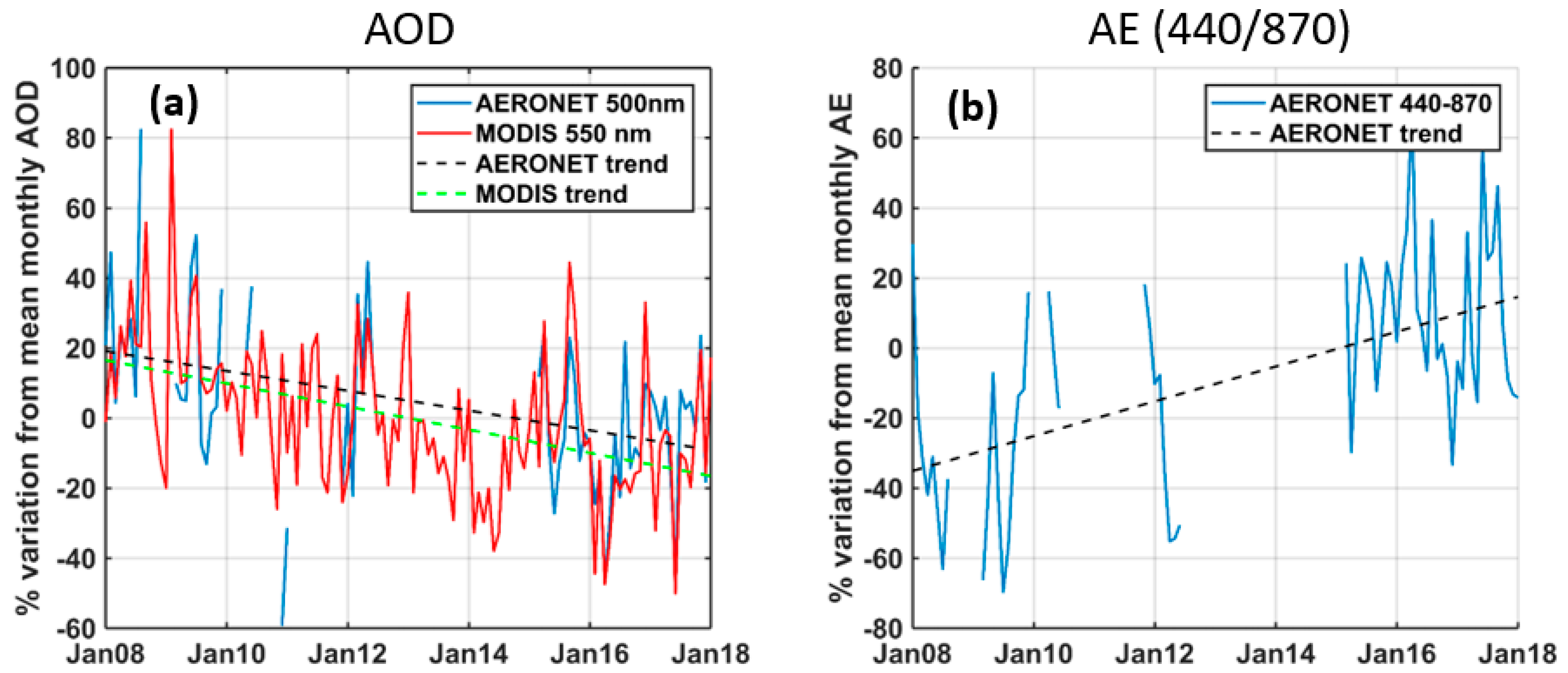
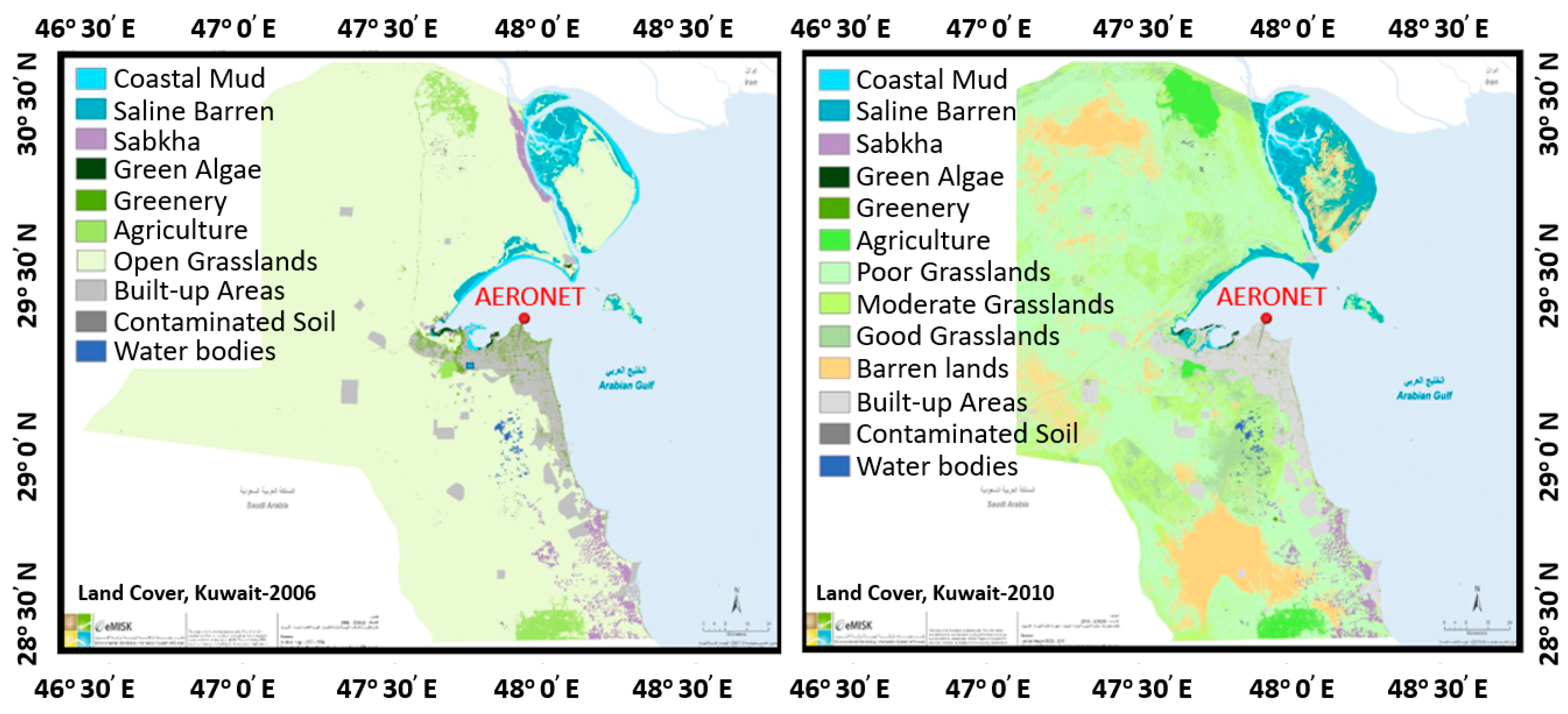
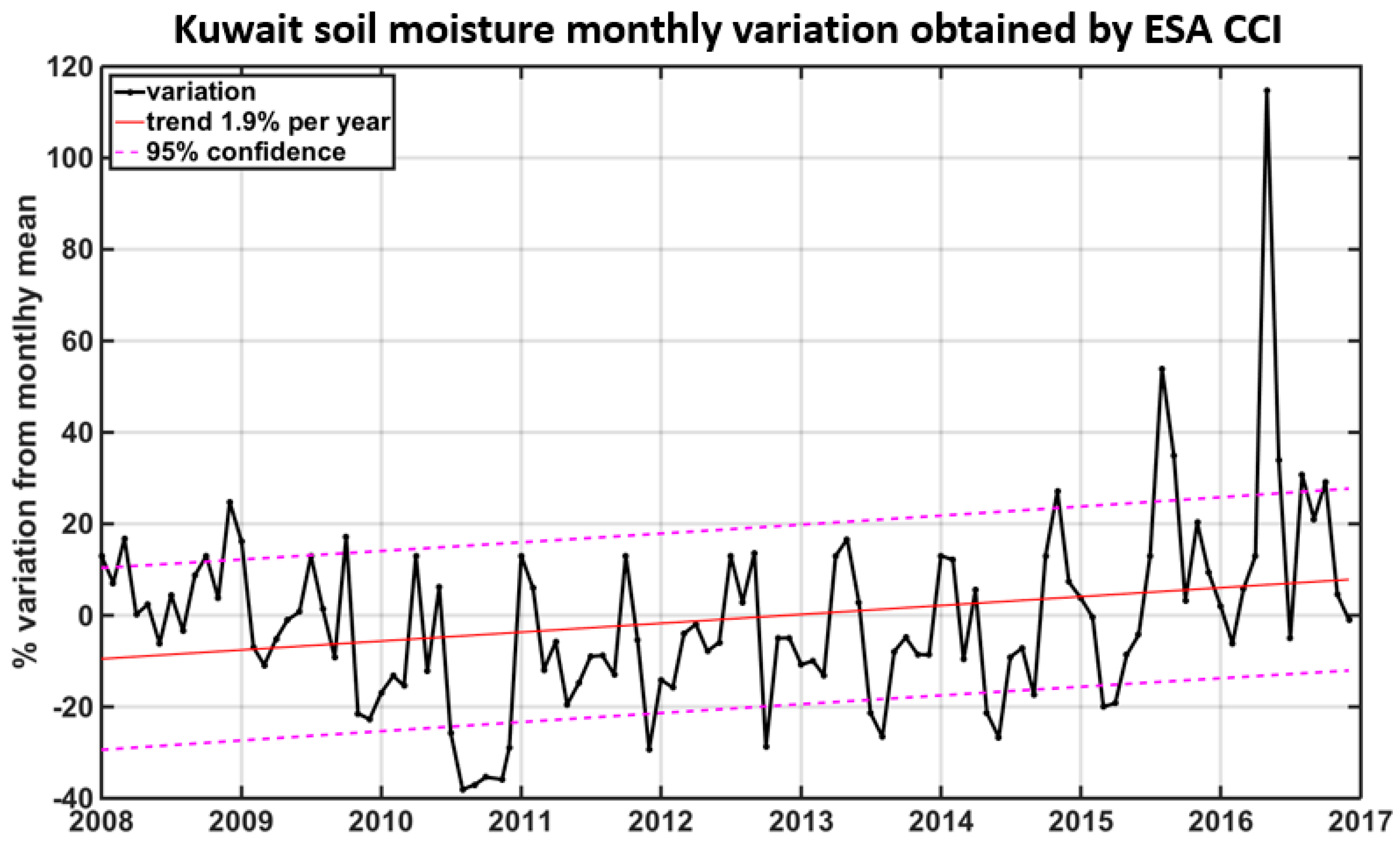
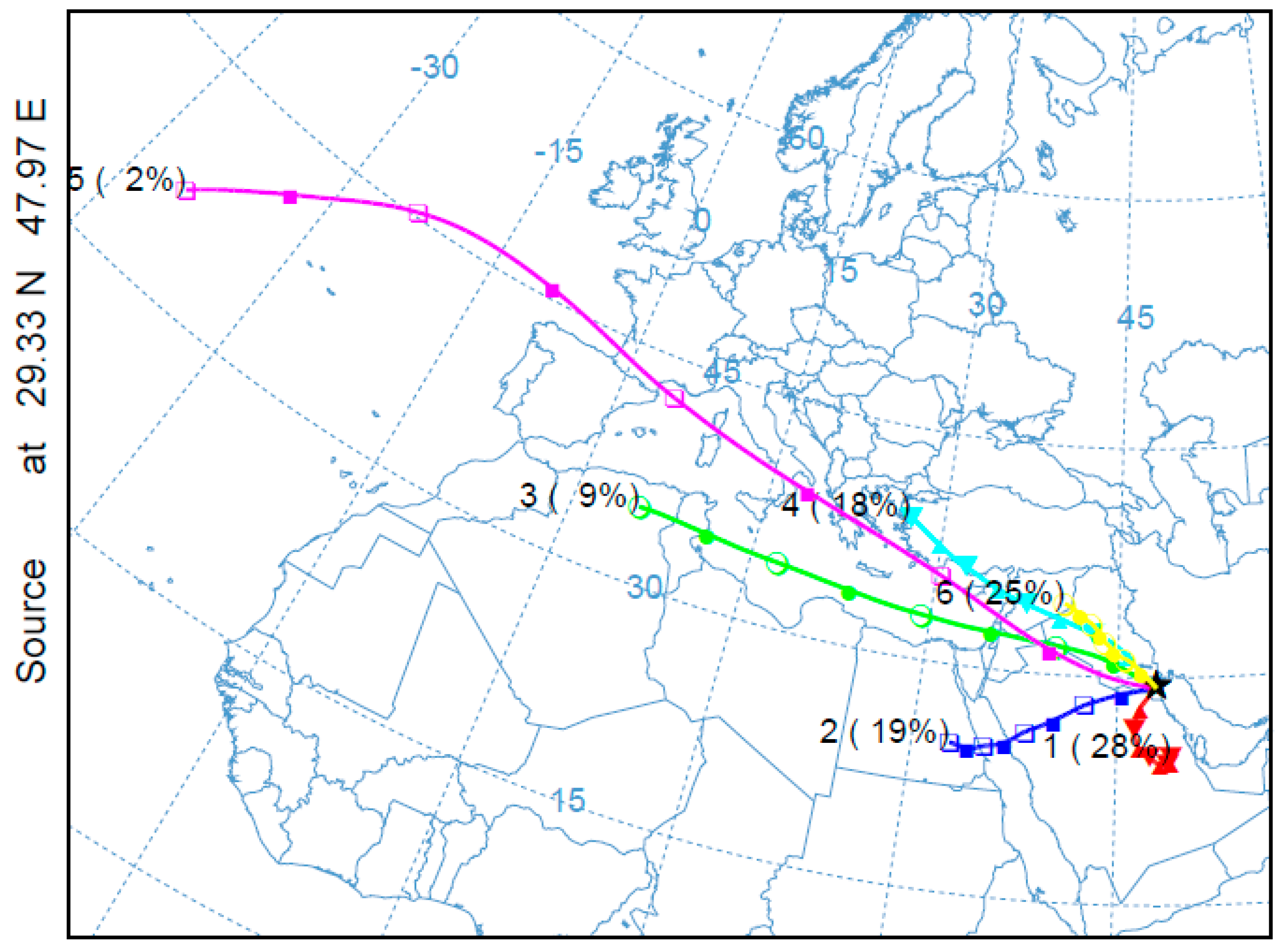

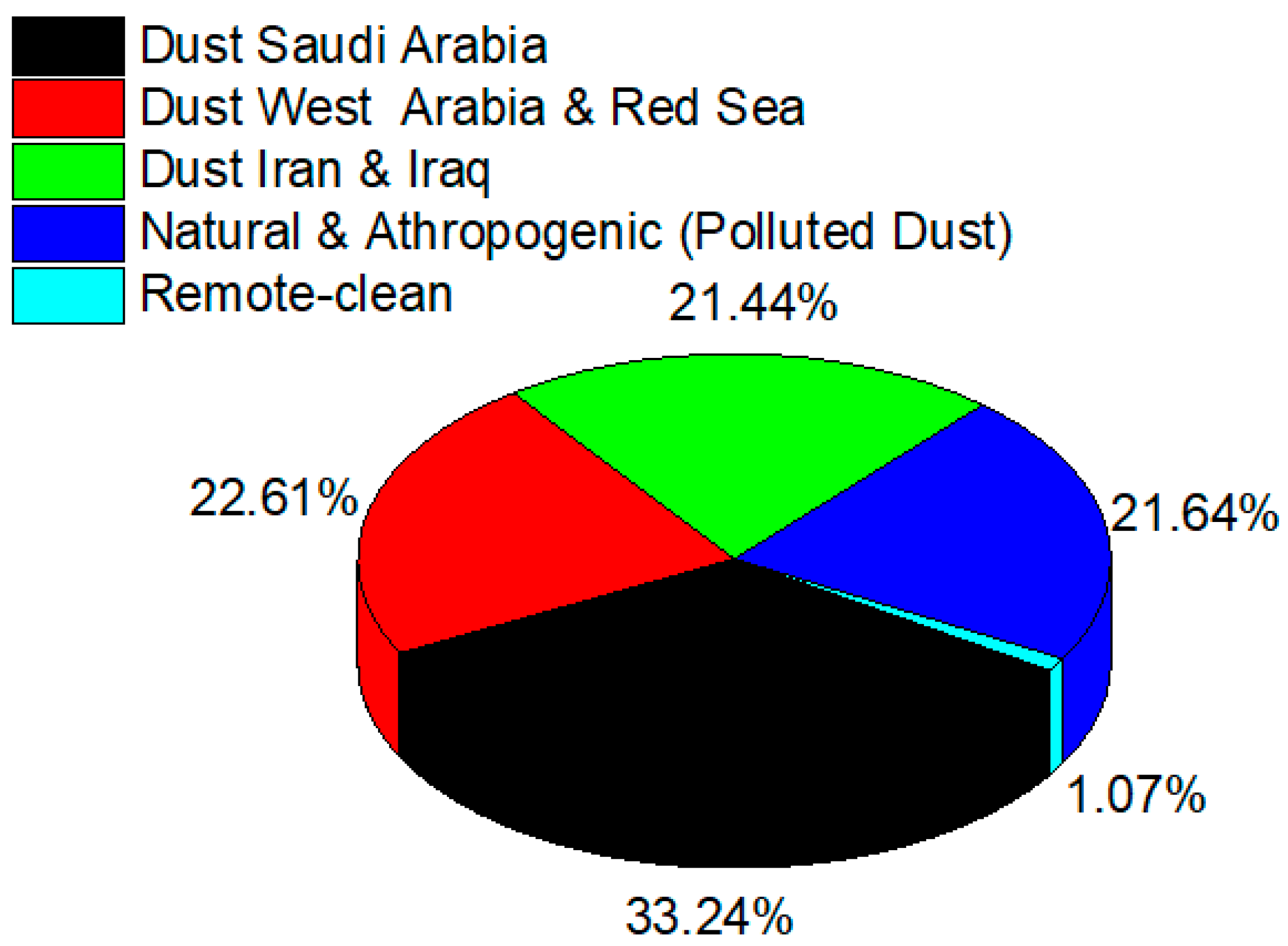
| Optical Property | Average ± Std. | Min.–Max. | 1st Quartile–Median–3rd Quartile |
|---|---|---|---|
| AOD340 | 0.57 ± 0.31 | 0.05–2.92 | 0.21–0.52–0.75 |
| AOD380 | 0.54 ± 0.30 | 0.06–2.94 | 0.20–0.50–0.71 |
| AOD440 | 0.49 ± 0.29 | 0.05–2.92 | 0.17–0.45–0.64 |
| AOD500 | 0.45 ± 0.29 | 0.04–2.91 | 0.15–0.40–0.58 |
| AOD675 | 0.39 ± 0.28 | 0.03–2.90 | 0.12–0.33–0.48 |
| AOD870 | 0.36 ± 0.28 | 0.03–2.88 | 0.10–0.29–0.45 |
| AOD1020 | 0.34 ± 0.27 | 0.02–2.85 | 0.09–0.27–0.42 |
| AOD1640 | 0.27 ± 0.24 | 0.01–2.44 | 0.06–0.20–0.35 |
| AE440/870 | 0.61 ± 0.39 | −0.03–1.74 | 0.14–0.57–0.91 |
| Cluster | Provenance Fraction % | Source Influence | Main Direction | Mean AOD500 (Standard Error) | Mean AE (Standard Error) |
|---|---|---|---|---|---|
| CL1 | 28 | Arabian Desert Dust | S | 0.55 (0.02) | 0.63 (0.03) |
| CL2 | 19 | Arabian Desert and Red Sea | SW | 0.55 (0.03) | 0.52 (0.03) |
| CL3 | 9 | Mediterranean and Middle East | WNW | 0.47 (0.03) | 0.38 (0.03) |
| CL4 | 18 | Turkey Anthropogenic and Iraq-Syria dust | NW | 0.32 (0.02) | 0.52 (0.03) |
| CL5 | 2 | Atlantic and Europe (anthropogenic-negligible) | NNW | 0.25 (0.02) | 0.72 (0.03) |
| CL6 | 25 | Desert Dust from Iran and Iraq | N | 0.40 (0.02) | 0.68 (0.03) |
© 2018 by the authors. Licensee MDPI, Basel, Switzerland. This article is an open access article distributed under the terms and conditions of the Creative Commons Attribution (CC BY) license (http://creativecommons.org/licenses/by/4.0/).
Share and Cite
Kokkalis, P.; K. Al Jassar, H.; Solomos, S.; Raptis, P.-I.; Al Hendi, H.; Amiridis, V.; Papayannis, A.; Al Sarraf, H.; Al Dimashki, M. Long-Term Ground-Based Measurements of Aerosol Optical Depth over Kuwait City. Remote Sens. 2018, 10, 1807. https://doi.org/10.3390/rs10111807
Kokkalis P, K. Al Jassar H, Solomos S, Raptis P-I, Al Hendi H, Amiridis V, Papayannis A, Al Sarraf H, Al Dimashki M. Long-Term Ground-Based Measurements of Aerosol Optical Depth over Kuwait City. Remote Sensing. 2018; 10(11):1807. https://doi.org/10.3390/rs10111807
Chicago/Turabian StyleKokkalis, Panagiotis, Hala K. Al Jassar, Stavros Solomos, Panagiotis-Ioannis Raptis, Hamad Al Hendi, Vassilis Amiridis, Alexandros Papayannis, Hussain Al Sarraf, and Marwan Al Dimashki. 2018. "Long-Term Ground-Based Measurements of Aerosol Optical Depth over Kuwait City" Remote Sensing 10, no. 11: 1807. https://doi.org/10.3390/rs10111807






